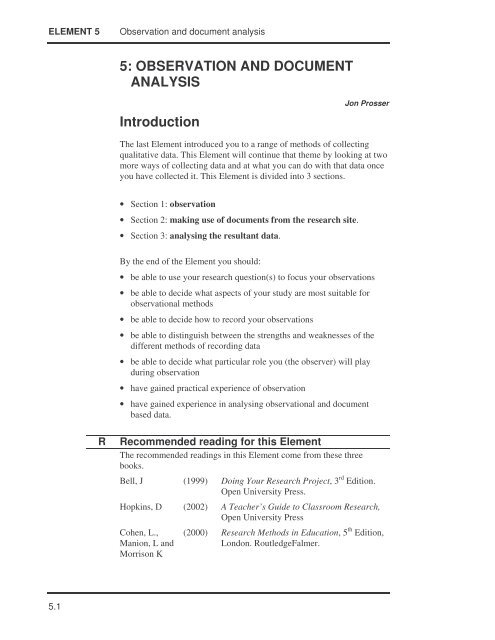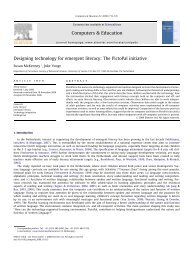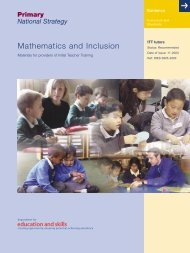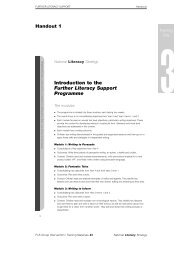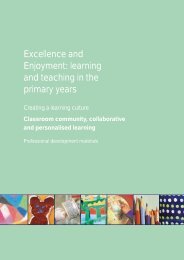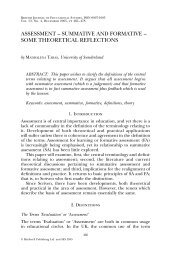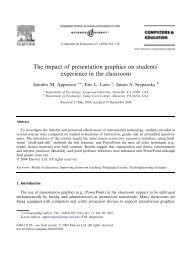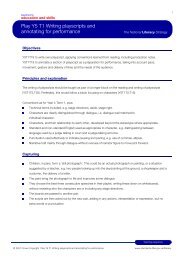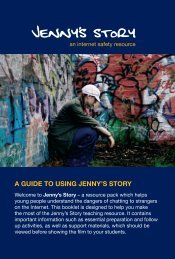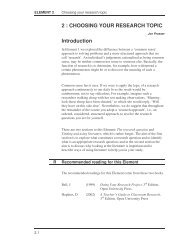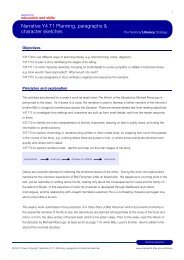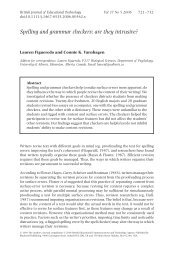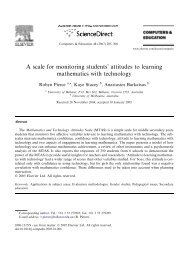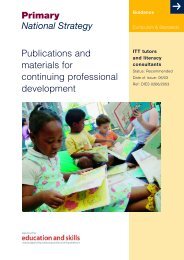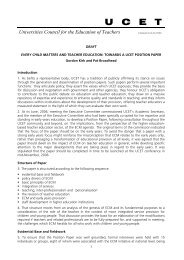Observation and document analysis by John Prosse.pdf - PGCE
Observation and document analysis by John Prosse.pdf - PGCE
Observation and document analysis by John Prosse.pdf - PGCE
You also want an ePaper? Increase the reach of your titles
YUMPU automatically turns print PDFs into web optimized ePapers that Google loves.
ELEMENT 5<strong>Observation</strong> <strong>and</strong> <strong>document</strong> <strong>analysis</strong>5: OBSERVATION AND DOCUMENTANALYSISIntroductionJon <strong>Prosse</strong>rThe last Element introduced you to a range of methods of collectingqualitative data. This Element will continue that theme <strong>by</strong> looking at twomore ways of collecting data <strong>and</strong> at what you can do with that data onceyou have collected it. This Element is divided into 3 sections.• Section 1: observation• Section 2: making use of <strong>document</strong>s from the research site.• Section 3: analysing the resultant data.By the end of the Element you should:• be able to use your research question(s) to focus your observations• be able to decide what aspects of your study are most suitable forobservational methods• be able to decide how to record your observations• be able to distinguish between the strengths <strong>and</strong> weaknesses of thedifferent methods of recording data• be able to decide what particular role you (the observer) will playduring observation• have gained practical experience of observation• have gained experience in analysing observational <strong>and</strong> <strong>document</strong>based data.RRecommended reading for this ElementThe recommended readings in this Element come from these threebooks.Bell, J (1999) Doing Your Research Project, 3 rd Edition.Open University Press.Hopkins, D (2002) A Teacher’s Guide to Classroom Research,Open University PressCohen, L.,Manion, L <strong>and</strong>Morrison K(2000) Research Methods in Education, 5 th Edition,London. RoutledgeFalmer.5.1
ELEMENT 5<strong>Observation</strong> <strong>and</strong> <strong>document</strong> <strong>analysis</strong>Section 1: <strong>Observation</strong>See your answersto activity 1 page2.6RThe first major point to note is that schools <strong>and</strong> colleges are busy places.A great deal can be observed there. The first thing you must decide is,'What am I going to observe?'. As always, such decisions will bedetermined <strong>by</strong> the underlying research purpose which requires that someform of observation needs to be undertaken. The sort of researchquestions where some form of observation would be appropriate are:• Do children in mixed classes behave differently from those in singlesex classes?• What sorts of interaction takes place between teachers <strong>and</strong> pupils?• What proportion of teacher time is spent on task?• At what time in the day/week are teachers most busy <strong>and</strong> what dothey do at these times?None of these questions can be sensibly explored without observing thesituation. Remember that observation is particularly important becauseit has the potential to give us insights into what people actually do ratherthan what they say they do or what they think they do. In Element 2 youdetermined your research topic <strong>and</strong> went on to decide your researchquestion(s) <strong>and</strong> the issues that your study would explore. Look back atthese now <strong>and</strong> identify what particular aspects could usefully beexplored using observation. Remember that observation is only one of anumber of techniques that may be used to collect data. Remember toothat it would be unusual, indeed unwise, to rely on only one method ofdata collection <strong>and</strong> that observational work should be used tocomplement other methods.ReadingHave a look at Chapter 7 of Hopkin’s book – methods of observation inclassroom researchT Task 1Make a brief list here of those aspects of your researchquestion(s) that you feel are most appropriate for observation.F Feedback on Task 15.2
ELEMENT 5<strong>Observation</strong> <strong>and</strong> <strong>document</strong> <strong>analysis</strong>If our research question were The induction of new teaching staff inChalfont School during 1995 a number of possibilities for observationwould be available. We could, for example, choose to observe:• the first day of the induction programme• pre-determined sessions such as discussion groups or short talks <strong>by</strong>department heads• informal periods such as teachers during their coffee breakSee Element 3Recording DataGiven that the research purpose defines the focus, the next question is,'How will I record my observational data?' There are, essentially, fourmain methods of collecting information.• via memory• via written notes• via pre-determined schedules• via mechanical devices – audio/video tape, cameraRReadingRead page 188 of Cohen, Manion <strong>and</strong> Morrison’s book for some goodtips on recording observational data.5.3
ELEMENT 5<strong>Observation</strong> <strong>and</strong> <strong>document</strong> <strong>analysis</strong>See Element 4 formore informationon ways to recorddata.Each method has its own advantages <strong>and</strong> disadvantages. Thus:• Memory is unobtrusive <strong>and</strong> helps retain the ‘naturalness’ of the eventbeing observed. But its limits are in the amount that can beremembered <strong>and</strong> the accuracy of that memory.• Written notes are very adaptable to different circumstances, but theymay suffer from limited reliability (i.e. would another researchermake similar observations <strong>and</strong> notes of a similar event?)• Pre-determined schedules are reliable, but may not fit exactly thespecific circumstances of any given observation.• Mechanical devices provide very full <strong>and</strong> reliable evidence but canbe very intrusive. They are also time consuming to analyse. A further,purely practical, difficulty is that camcorders, cameras <strong>and</strong> taperecorders may break down or simply not function at all. So it is a wiseprecaution to have a backup of some sort such as written notes.Element 6, Section3 goes into validityin greater detailParticipant observationWhatever form of recording you use, any visit to a teaching environmentwill disrupt the very activity you wish to observe. This creates problemsof validity. In other words, does the situation you are observing describeor reflect what it is supposed to describe or reflect? This effect is likelyto be strongest (<strong>and</strong> your data least reliable) when you first start yourobservation. It is best to make your observation a regular event, so thatwhatever you observe can settle down to being 'normal'. So remembernot to rely on initial data. Wait until your participants have, at least to adegree, accepted the situation.That researcherlady thinks wecan’t see herWhen observing a situation or event those being observed may benervous or seek to put up a ‘front’ of some sort. Since ‘naturalness’ isimportant to any qualitative research you should consider ways ofpreserving or encouraging it. You could act covertly so that participantsare unaware that they are being observed. However, this raises ethicalquestions which should be addressed before such a stance is taken.Alternatively you could operate overtly, such that participants are awarethat they are being observed.The role you play whilst collecting data is often referred to as‘participant-observer’ role. Participant-observation is often associatedwith an ethnographic style of research. This means that the researcherjoins a group or organization, participating to a greater or lesser extent inwhat they are doing. The researcher is then in a good position to observepatterns of social interaction <strong>and</strong> to talk informally with participants. Theresearcher shares as intimately as possible in the life <strong>and</strong> activities ofthose they are studying. The aim is to gain the deepest possibleunderst<strong>and</strong>ing of the research participant’s meanings <strong>and</strong> perspectives5.4
ELEMENT 5<strong>Observation</strong> <strong>and</strong> <strong>document</strong> <strong>analysis</strong>within their normal social context. Of course this can go too far.Anthropologists have a term, 'going native’, to describe a researcher whogets so involved <strong>and</strong> active with subjects that their original intentions getlost.Think about your own research project <strong>and</strong> consider carefully where onthe participant-observer continuum you wish to be when you are doingyour own observation. You could, for example, carry on your normalduties whilst making notes occasionally in a hard-backed book(emphasizing the participant role). Alternatively, you could take a ‘flyon-the-wall’approach <strong>and</strong> using a structured observation record what ishappening on a clipboard for a designated period of time (emphasizingthe observer role).T Task 2Now have another look at chapter 7 of David Hopkins’s book ATeacher’s Guide to Classroom Research. Use this information tohelp you make the following decisions about your own researchproject.1. Will you be carrying out covert or overt observation, or acombination of the two in your research? Give reasons for yourchoice.2. What sort of participant-observer role will you adopt whilstobserving?3. What steps will you take to ensure a degree of ‘naturalness’ ispresent during your observation?5.5
ELEMENT 5<strong>Observation</strong> <strong>and</strong> <strong>document</strong> <strong>analysis</strong>F Feedback on Task 21. This is not an easy question to answer <strong>and</strong> researchers take differentstances on this sensitive issue. One approach could be, given theabove research question, to simply to adopt an ‘up front’ or overtapproach <strong>and</strong> seek the help <strong>and</strong> support of those people who run theprogramme <strong>and</strong> also those who participate in it. The overt optionwould perhaps be less appropriate if we were going to evaluate theinduction programme or if the research question were particularlysensitive.2. Exactly where on the participant–observer continuum your role willbe will depend on the answer to the next question.3. This is an important question. One way of ensuring a degree ofnaturalness in your study would be to go through the course yourselfas though you were a teacher being inducted. Another approachwould be to actually teach some parts of the programme so that youcould find out ‘first-h<strong>and</strong>’ what it is like to experience such aprogramme in one way or another. In this way you become part ofwhat you are observing <strong>and</strong> not an object of curiosity or a ‘spy’.5.6
ELEMENT 5<strong>Observation</strong> <strong>and</strong> <strong>document</strong> <strong>analysis</strong><strong>Observation</strong> schedulesYou have made some very important decisions <strong>by</strong> this stage but it isworth remembering that they are not written on tablets of stone. You canalter them when further information is taken into consideration. Beforeyou carry out your observation:• use your research question to decide the focus of your observations• give some thought to the sorts of observations that will be useful toyour research• before you collect any data, make sampling decisions, i.e. who, what,where, <strong>and</strong> when to collect data. Think carefully about these since inyour final report you will need to justify why, for example, you haveselected those particular people to observe at that particular time.Finally, you should decide how you intend to record the event you wishto observe <strong>and</strong> you should have your memory, notebook, schedule, taperecorder, camera <strong>and</strong>/or camcorder at the ready.Let us now consider in a little more detail the process of recordingobservational data using a schedule.Perhaps one of the most common mistakes in carrying out observationsis doing so without focussing. This leads to difficulties in samplingdecisions but more importantly it means the data are extremely difficultto analyse. A good way of both focussing your observations <strong>and</strong> aidingthe recording of data is to use an observation schedule. If you work outin advance what you want to observe, you can develop a detailedschedule which itemises the various categories to be used in collectingthe observational record. If you do this you should take care to identifythe categories which differentiate between different sorts of data. Whendevising categories make sure they meet the following key criteria:• the definition of each item must be unambiguous to allow for recordsto be taken without disagreement on whether a particular aspect ofbehaviour falls into one category or another• that the set of categories used covers all the behaviours with whichthe research is concerned.It follows from these two that there must be no overlap betweencategories. It is worth trialling an observation schedule before using it inearnest. Give a colleague a copy of your schedule. Then both observe thesame event. Check afterwards to see whether you have both put the sameobservations in the same categories.5.7
ELEMENT 5<strong>Observation</strong> <strong>and</strong> <strong>document</strong> <strong>analysis</strong><strong>Observation</strong> schedules are not easy to use <strong>and</strong> some practice is requiredin order to underst<strong>and</strong> their strengths <strong>and</strong> weaknesses, <strong>and</strong> how best toapply them. The next task will give you some practice in this.T Task 3Suppose we wish to research off-task behaviour ofadministrators in the Education system. Clearly observationwould be play an important role in such a study.Have they goneyet?We want you to collect observational data for this study using theschedule on the next page. But before you start, think about howyou are actually going to do this in practice. If you choose to tellthe administrators exactly what you intend to observe then youwould probably find that they all work diligently on task for theperiod of observation. Your data may not be valid or reliable. Butsuppose you choose not to tell them what you are doing. If youthen st<strong>and</strong> over them with pen poised over clipboard, they aregoing to wonder what you are doing <strong>and</strong> you will be in an ethicalqu<strong>and</strong>ary.One way out of this impasse would be to ask for their permissionto observe them for a short amount of time, for example 10minutes. You could (correctly) say it is for a course you are doing<strong>and</strong> you could state in general terms what you will be observing,for example 'I want to get a picture of the sort of things you doduring an ordinary day’. The process of obtaining permission tocollect data is called accessing <strong>and</strong> the first practical step inobtaining your data is always to gain access to people, places orevents, to get permission to observe or interview people.For this particular task try to find a friendly administrator who willbe willing to act as a 'guinea pig’ for you - but if this is impossiblelook for anyone who is carrying out a specific task. It does notmatter much what the task is. Anyone carrying out any task islikely to spend some time off-task.All you have to do is scan one person (or more if you feelconfident) over a period of ten minutes noting down what they aredoing in the categories which follow:1. talking not related to the task in h<strong>and</strong>2. doodling3. daydreaming4. w<strong>and</strong>ering around5. working at other tasks unrelated to the task in h<strong>and</strong>5.8
ELEMENT 5<strong>Observation</strong> <strong>and</strong> <strong>document</strong> <strong>analysis</strong>6. interacting with other people not related to the task in h<strong>and</strong>7. using a pencil sharpener, looking for a pen, throwing paperaway etc8. otherAs an example of the sort of data you will obtain the schedule foradministrator Joan is given:Administrator: Time (minutes) 1st 2nd 3rd 4th 5th 6th 7th 8th 9th 10thOff-task activity We can see that Joan was on task for 4 of the 10 minutes (duringthe 3rd, 4th, 8th <strong>and</strong> 10th minutes) <strong>and</strong> that for the remaining sixminutes Joan was off-task. Remember to include an ‘other’category (here it was no. 8) in case some observations cannot beplaced in the designated category list. It is worth noting that somecategories are not easy to apply, for example, during the secondminute how can we be sure that Joan is daydreaming since shemay have been thinking <strong>and</strong> therefore on task.This type of observation is of particular pertinence to theclassroom; observing teachers, classroom assistants, pupils <strong>and</strong>groups of pupils reveals a great deal about teaching <strong>and</strong> learning.Now you try. Carefully select someone <strong>and</strong> use the schedule tocollect data on one subject. Use the space below to record yourfindings.F Feedback on Task 3This is a matter of putting the scheme into practice.T Task 4Now read Chapter 11 of Judith Bell’s (1999) book Doing YourResearch Project, which is concerned with observational studies.Take particular notice of the checklist on pages 166-167.When you have absorbed this material, select <strong>and</strong> observe someevent related to your research topic. You may wish to carry out5.9
ELEMENT 5<strong>Observation</strong> <strong>and</strong> <strong>document</strong> <strong>analysis</strong>more than one observation which will provide you with insights oranswers to your research question. Record your findings here.F Feedback on Task 3This is a matter of devising a scheme <strong>and</strong> putting it into practice.Section 2: <strong>document</strong>sDocuments broadly include any papers, especially official ones, whichprovide more or less direct evidence of decisions, transactions, status,thoughts, debates or actions, which are directly or indirectly related tothe purpose of a research inquiry. Documents may be contemporary orhistorical in nature <strong>and</strong> include both text <strong>and</strong> visual data. Documentswhich are considered primary sources of data would include, forexample, annual reports, minutes of meetings, personal diaries,memor<strong>and</strong>a, records, letters, files, institutional prospectuses, videos,photographs, diagrams, or catalogues.Documents are a useful source of evidence but they have theirlimitations. One problem with them is that we may not know how theycame into being in the first place or who wrote them. Another problem ispointed out <strong>by</strong> Andrew (1985) who makes an important point withregard to ‘complete’ records:T Task 5Documents have differential survival rates <strong>and</strong> thosewhich survive do not always provide all the informationrequired....The answers to a great many questions aresimply not available, since the necessary records eithernever existed or failed to survive. (p. 156)About 40 minutesworkThink about your research question again. Make a list of the sortsof <strong>document</strong> you could find within your working environment which5.10
ELEMENT 5<strong>Observation</strong> <strong>and</strong> <strong>document</strong> <strong>analysis</strong>might be relevant to your study. Note down any problems youforesee in gaining access to these <strong>document</strong>s or using them inyour study. For example, are there any restrictions on yourpublishing them?An example of analysing <strong>document</strong>sLater, in Section 3, we will consider in some depth ways of analysingqualitative data. However, it is worth gaining experience of obtaining<strong>document</strong>s <strong>and</strong> making sense of them. Let us consider the way teacherscommunicate with those outside the institutions or organisations theywork for. Of course they communicate in a variety of ways, both verbal<strong>and</strong> non-verbal. Let us first consider written communications, i.e.<strong>document</strong>s, which are sent from the school/college to the outside world.Our research question might be concerned with information about howparents or guardians of reception class children are prepared prior totheir arrival at a primary school. We could identify, for example, lettersto parents or guardians of children who are soon to be admitted to theschool. The first task would be to obtain copies of the <strong>document</strong>s sent topotential parents or guardians. This may not be as simple as it soundssince different sorts of information may need to be sent to differentpeople. In other words there may not be a 'st<strong>and</strong>ard’ letter.Having obtained the <strong>document</strong>s, we need to make sense of or analysethem. Let us suppose that we are particularly interested in the languageused when writing to potential parents or guardians. Suppose, too, thatwe are using a definition of 'language' which includes any diagrams orphotographs enclosed. How are we going to analyse them? What are wegoing to look for? In order to decide this we need to think about ourpurpose in carrying out this piece of research.Our research question is concerned with communication. However, thisis a very broad <strong>and</strong> unfocussed term. We could narrow it down <strong>by</strong>looking at a particular aspect of communication, for example 'factualinformation’. Equally, we may have good reason to want to explore thistype of communication in general terms. If so, we should simplyapproach the data without any particular prior concerns. Let us makethings hard for ourselves <strong>and</strong> take the latter stance.The next step is to ask a range of questions of the <strong>document</strong>s before us.We could begin <strong>by</strong> making the following kinds of quantitative <strong>analysis</strong>:• approximately how many words are there per page?• how many paragraphs are there per page?5.11
ELEMENT 5<strong>Observation</strong> <strong>and</strong> <strong>document</strong> <strong>analysis</strong>• How readable is the <strong>document</strong>. There are many ways of calculatingthis. A nice, simple yet effective one is <strong>by</strong> using the SMOG formula.The number of words of three or more syllables in every thirtysentences equals P. Reading Age = P+8.• How is the space utilised? Compare the proportion of text tophotographs, lists, diagrams, etc.• What percentage of the <strong>document</strong> is given over to welcoming <strong>and</strong>reassuring the potential parent or guardian of the child about to beenrolled in the school? Compare this with the percentage ofinstructions <strong>and</strong> lists (for example, what uniform or P.E. kit parents<strong>and</strong> guardians may need to buy before school term starts).• Next we could look at the ‘tone’ of the <strong>document</strong>:• Are there any words which are 'technical’ <strong>and</strong> if so are theyexplained?• What is the general tone of the <strong>document</strong>, e.g. ‘cold’, ‘officious’,‘neutral’, ‘warm’, ‘welcoming’?• Is the <strong>document</strong> signed <strong>by</strong> a member of staff or has a rubber stamp ofsome sort been used?• How has the <strong>document</strong> been duplicated? Is it a stencil copy, aphotocopy or has it been produced on a laser printer?Obviously, we could go further with our <strong>analysis</strong> <strong>by</strong> exploring the actualcontent of the <strong>document</strong> <strong>and</strong> considering how effective it is in preparingthe potential parent or guardian for their child’s entrance to school. Our<strong>analysis</strong> would raise questions which would need to be answered <strong>by</strong>further data collection. We could interview the author of the <strong>document</strong> tofind out what they intended to achieve when they wrote it. Also we couldidentify a sample of potential parents or guardians <strong>and</strong> ask them for theirviews on the <strong>document</strong>. In this way we would be able to compare <strong>and</strong>contrast the differing perspectives.Analysing participant observation <strong>and</strong> <strong>document</strong>baseddataIn general, the comments that follow could be said to be true ofanalysing any qualitative data. Although here we will use the term<strong>analysis</strong>, a friendlier <strong>and</strong> perhaps less threatening term might beinterpretation. It is important to remember that although qualitative datais descriptive you must go beyond simple description <strong>and</strong> provideinterpretations of your data. Being analytical is central to being aresearcher.<strong>Observation</strong>al data, like other forms of qualitative data, are not lookedupon favorably <strong>by</strong> all researchers, particularly when viewed from ascientific perspective. Cohen, Manion <strong>and</strong> Morrison (2000) say:5.12
ELEMENT 5<strong>Observation</strong> <strong>and</strong> <strong>document</strong> <strong>analysis</strong>The accounts that typically emerge from participantobservations are often described as subjective, biased,impressionistic, idiosyncratic <strong>and</strong> lacking in the precisequantifiable measures that are the hallmark of surveyresearch <strong>and</strong> experimentation. (p. 313)The quote above represents a ‘scientific’ perspective of participantobservation. <strong>John</strong>son (1984) gives an alternative perspective:In qualitative research the work is intended to beintensive <strong>and</strong> illuminative <strong>and</strong> will not usually lay claimto being representative <strong>and</strong> generalisable. Insummary, the main requirement in qualitative researchdesigns is to give oneself the chance to be enlightened<strong>and</strong> to avoid a research situation which rules outexploration <strong>and</strong> open mindedness. (p. 22)In analysing data collected through observation we are essentiallylooking for patterns in order to build up a picture of the phenomenaobserved. We need this picture to be in some sense typical orcharacteristic. As the quotation from <strong>John</strong>son makes clear, claims aboutthe typicality of the phenomena observed can be made only in terms of'the case' being researched. However, readers of an account of casestudyresearch may generalise from the particular sample to a widerpopulation <strong>by</strong> relating the events portrayed to their own experience.Therefore, it is important to be clear from the beginning about the kindof claims you want to make about the data you have collected <strong>by</strong>observation.In participant observation you collect the data you gain from theobservation of subjects in the form of a schedule, field-notes, or aresearch diary. Then you add to them continuously over the researchperiod to build up a picture of the phenomena. The 'off-task’ schedulethat you used earlier could be the basis of a number of observationswhich would include a 10 minute slot each half-day throughout theworking week or a variety of half days during a week throughout a year.In this way we can build up a picture of 'off-task’ behaviour over aweekly or yearly period. This may tell us something about the annualworking pattern of an administrator or what parts of the day/week/yearthey work most effectively.An important aspect of participant observation is that it is unusual toleave the data lying dormant, as it were, to be analysed only at the end ofthe fieldwork period. Continual reading through <strong>and</strong> reflection on theschedules, videos or field-notes will often highlight issues worthy offurther investigation. For example, you might note from yourobservations that a particular college administrator uses mornings tocarry out the bulk of their work, leaving afternoons more flexible <strong>and</strong>therefore with potential for socializing. You may then want to go on tocollect further data to either substantiate or refute this workinghypothesis, or to carry out an in-depth interview with the administrator5.13
ELEMENT 5<strong>Observation</strong> <strong>and</strong> <strong>document</strong> <strong>analysis</strong>on this particular issue. So, as you can see, researchers make sense oftheir data soon after they have collected it. This enables them to refinethe focus of their studyThe ongoing <strong>analysis</strong> of data gathered through observations <strong>and</strong> fieldnotesis used to help progressive focussing <strong>and</strong> in generating groundedtheory which explains the phenomena observed. Progressive focussingis the continual funnelling process which limits <strong>and</strong> clarifies the scope,subject <strong>and</strong> structure of a research project. In this process it is notuncommon for the initial research question to be transformed almostbeyond recognition. The fieldwork may increasingly reveal that thisquestion simply did not address the issue that was fundamental to theproblem under review. Grounded theorising is the ongoing process ofdeveloping hunches, ideas <strong>and</strong> interpretations of the data. These serve toguide data collection <strong>and</strong> are refuted, or substantiated <strong>and</strong> developed, inthe light of the new data collected. Theory building <strong>and</strong> data collectioncan therefore be viewed as interrelated.Remember that it is important in doing this kind of <strong>analysis</strong> to be alert tothe danger of 'going native'. This involves getting so caught up in theevents that you are supposed to be researching that you fail to examinethem critically <strong>and</strong> take for granted the very phenomena that should beregarded as problematic. Teachers <strong>and</strong> others working in the educationsystem carry out research into aspects of their own work <strong>and</strong> this hashelped to improve practice. However, practitioners frequently take theireveryday practice for granted <strong>and</strong> they may be blinkered <strong>by</strong> priorassumptions <strong>and</strong> personal values. This is why it is vital to use astructured approach (a research approach) to making sense of data. Away of avoiding the charge of being blinkered <strong>by</strong> prior assumptions is <strong>by</strong>searching for exceptions or negative cases which disprove previouslyheld or emerging hypotheses - a process referred to as analyticalinduction in the methodology literature. It is a useful exercise to try tofind ways of making the familiar strange or providing yourself withdifferent frameworks for thinking about your data.It is important not to put off analysing your data until after you have leftthe field. There are two good reasons for this. First of all, you will becollecting quite a lot of data <strong>and</strong> if you leave <strong>analysis</strong> until the lastmoment you will find it a daunting, if not psychologically damaging,process. The second reason is that <strong>analysis</strong> in the field helps focusfurther data collection <strong>and</strong> refine emerging ideas <strong>and</strong> concepts.Therefore, as your data come in, try to make sense of them as soon aspossible. You will probably find it helpful to adopt the followingapproach.• Force yourself to make decisions about the type of study you want toaccomplish.• Force yourself to make decisions that narrow the study.• Develop analytic questions.5.14
ELEMENT 5<strong>Observation</strong> <strong>and</strong> <strong>document</strong> <strong>analysis</strong>• Plan data collection sessions in the light of what you have found inprevious data collection.• Bring together in a field diary what you are learning from the varioussorts of data you collect.• Try out your ideas on key informants.• Begin exploring the literature while you are in the field.Practical guidelines for interpreting qualitative dataRemember that your <strong>analysis</strong> must be effective. This means that whetheryou are interpreting observational, <strong>document</strong>ary, interview orquestionnaire data you must always bear in mind that:1. data <strong>analysis</strong> is more than description; it involves interpretation2. for the purpose of research, interpretation must be systematic <strong>and</strong>reliable3. there should be coherence of interpretation, i.e. interpretation shouldreflect patterns in the data.Once you have got your information from a series of interviews/observations/ questionnaires/<strong>document</strong>s, you face two main tasks. Theseare:• to seek similarities where these exist• to identify diversity <strong>and</strong> variation around the common features.Now you can go on to analyse your data. You will find this easier if youfollow the steps outlined below. But remember that you have alreadydone some preliminary <strong>analysis</strong>. You have already made decisions aboutwhat to observe, what questions to ask, <strong>and</strong> whom to interview.Steps in data <strong>analysis</strong>This is also considered in Element 6a.1. Your data must have a purpose – to satisfy your research question.Your research question may involve a range of subsidiary questions.Code the data in terms of relevance to these subsidiary questions.Some data may be relevant to more than one. This first stage providesyou with the basis for deriving an overall picture of the sets of data,e.g. all teachers expressed anxiety about changes being made in thefunding of the education service but there was variation in the sourcesof such anxiety.5.15
ELEMENT 5<strong>Observation</strong> <strong>and</strong> <strong>document</strong> <strong>analysis</strong>2. The second stage is to look in more detail at the emergent pattern. Arethere any sub-patterns? For the above example, what forms ofanxiety have been expressed <strong>and</strong> how is each one constituted? Aresome of these forms of anxiety more widespread than others?Remember to code positive <strong>and</strong> negative data, e.g. while manyteachers admitted to anxiety about funding changes, a number wereenthusiastic about the prospect.3. Also look for patterns in terms of who is saying what, e.g. differencesbetween teachers from different schools, or differences betweencomments made <strong>by</strong> senior <strong>and</strong> junior teachers, or teachers fromdifferent year groups or different disciplines.4. The next two stages involve looking more critically at the data. Lookfor omissions. Were there things that you expected to come up whichdid not? For example no teacher mentioned the prospect of losingtheir jobs as a source of anxiety. Such omissions are useful in thatthey help you to reflect on the quality of the data. Is there any reasonfor feeling that participants were unprepared to comment on such atopic? Why did you, the interviewer, originally expect this to be anissue? Were there any issues for which you were unprepared? Dothey need following up in any way?5. Test the rules <strong>by</strong> which you have coded the data. Describe these rulesto a friend or colleague. Show him or her an unmarked sample of thedata you have analysed <strong>and</strong> ask them to analyse the data according toyour rules. (There is clear scope for team co-operation here). Anysubstantial variation in the patterns produced is worrying <strong>and</strong> willrequire a re-examination of the rules <strong>by</strong> which you are operating. Inany event, you should try to discuss your plans for data <strong>analysis</strong> withyour tutor.6. Have a 'rag-bag' category for data which do not demonstrably relateto your research question. This may be a fruitful source of data asyour research proceeds.Your aim here is to render data into a manageable form. You want thisform to be conducive to critical reflection <strong>and</strong> deeper underst<strong>and</strong>ing. Theprocess of <strong>analysis</strong> is a difficult <strong>and</strong> dem<strong>and</strong>ing one so it is extremelyimportant to give it the maximum time <strong>and</strong> effort necessary to make surethat your final research account is not merely a description of events,however lucid <strong>and</strong> well-ordered this might be. Try to consider therelationship between the findings on the various issues you haveidentified. For example you may find that contradictions emerge. Youmust try to explain these. Also you may find that your findings can becompared with those of related research <strong>and</strong>. Then you can look forexplanations for similarities <strong>and</strong> differences. Another way of analysingdata is to consider how findings at the local, micro-level of an institutionor organisation relate to national, macro-level events.5.16
ELEMENT 5<strong>Observation</strong> <strong>and</strong> <strong>document</strong> <strong>analysis</strong>T Task 6The data you have collected do not automatically provide youranswers. You need to interpret your raw information. As aresearcher your next task is to make sense of it.Note down your interpretations of the data you have collected <strong>by</strong>observation <strong>and</strong> then use these notes to explain how your findingsrelate to your research question(s).SSummaryIn this Element we have considered three important issues. The first twosections were concerned with data collection techniques – observation<strong>and</strong> <strong>document</strong>s – <strong>and</strong> both approaches are capable of yielding goodquality evidence. We also looked at how to record data, in particular thelimitations <strong>and</strong> strengths of each of the approaches. Finally, wediscussed <strong>analysis</strong>, initially in general terms <strong>and</strong> later in a morepragmatic way.Analysis <strong>and</strong> making sense of data collected are fundamental to theresearch enterprise. They are also perhaps the most difficult aspects ofthe process. Many researchers, even experienced ones, struggle withinterpreting the data. It is natural that you too may at first find this aspectdifficult <strong>and</strong> frustrating. Don’t be scared of ‘wrestling with the data’. Themost important thing to remember is that you must immerse yourself inthe data as soon as possible. Do not put off analysing them.A good way of forcing yourself to analyse is to start writing. The act ofwriting, of putting your ideas down on paper, forces you to organisethem – to analyse them.RReferences<strong>John</strong>son, D‘Planning small-scale research,' in Bell, J et al (Eds)(1984), Conducting Small-Scale Investigations inEducational Management, Open University.5.17
ELEMENT 5<strong>Observation</strong> <strong>and</strong> <strong>document</strong> <strong>analysis</strong>You might like to follow these up as extended reading.Andrew, A (1985) ‘In pursuit of the past: some problems in thecollection, <strong>analysis</strong> <strong>and</strong> use of historical<strong>document</strong>s,’ In Burgess, R (Ed) Strategies inEducational Research. Sussex, Falmer Press.370.78 BURBoth the following books contain a chapter discussing the process of<strong>analysis</strong> using data from participant observation:Hammersley,M, <strong>and</strong>Atkinson, P,(1983) Ethnography: Principles in Practice,Tavistock. 370.78 HamWood, P (1986) Inside Schools, Routledge5.18


